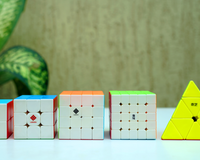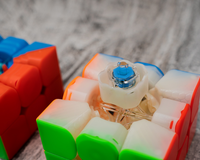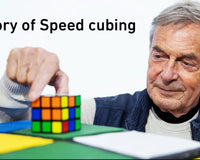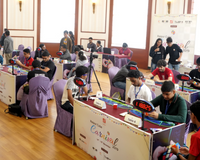F2L (First Two Layers) is the longest step in the CFOP method, and so is one of the most important to work on if someone wants to get much faster. Having learnt the fundamentals of solving F2L cases, this blog will focus on some of the more advanced techniques and solutions that you might find useful in your own solves.
Why is it important to learn F2L for Speedcubing?
In CFOP, the cube is solved layer by layer. Since F2L is a method that solves both layers at once, it is one of the most essential steps of speedcubing. Doing the layer by layer method just wastes time and takes a lot more moves. F2L is also much more intuitive and flexible since you have a lot more pieces to work with rather than in layer by layer, where there are fixed steps.
Number of Cases in Advanced F2L
If each corner-edge position is counted, there are a total of 42 F2L cases, which includes the solved case. So there are effectively 41 cases that have 41 algorithms.
Learning Advanced F2L
You can learn F2L intuitively or by looking up algorithms. There are pros and cons to both ways. Intuitive gets you in the flow of the solve easily and helps in furthering your understanding of the pieces. But there may be certain cases where the intuitive approach would be inefficient. Hence, the best way would be to do a mix of both. Start with the intuitive approach and then look up cases for which you use many moves or you can’t find a good enough solution. There are many resources and PDFs out there with multiple algorithms per case. Find one that works for you and incorporate it into your solutions. Further into the blog, I’ve listed a few case-specific tricks I have learnt and that I use in my everyday solves.
Keyhole

Keyhole is an underrated but very effective method for solving certain F2L cases. It uses empty slots and the flexibility of the D layer for cases with solved corners. For example, you have a solved corner in its correct slot but the edge is in the top layer. The usual method works by removing the corner, joining it with its edge, and then inserting it into the slot.
What can be done instead with keyhole is to move the D layer away, bringing an empty slot in its place. The edge is then inserted quickly and the D layer is moved back, solving the pair. This method can also be used for a solved edge and unsolved corner instead. If you’re comfortable with left-hand ring finger tricks like pushing, then this is a much faster and more efficient way of solving the case. You can see where keyhole gets its name, like inserting a key in an empty lock. Or in this case, the empty slot.
Check out 3x3 Collection
Multi-Slotting

Keyhole can be adapted to solve multiple pairs at once. This is fairly rare, so it isn’t by any means essential, but it may come in handy when you have many empty slots and a few solved pieces. Especially right after solving the cross or an x-cross. While you’re inserting your edge during keyhole, if you are able to join that edge with another corner in the top layer, then that corner will be inserted in the empty slot and moved back. If the empty slot’s edge is already solved, then what you have done is solve two pairs at once.
Another thing you can try to keep in mind is figuring out how your solutions affect other pieces. This isn’t exactly multi-slotting, but what you can do is make future pairs easier for yourself by adding one or two moves to your current pair’s solution. If there is a case where inserting a joined pair into its correct slot with R U2 R’ provides an easier next pair, that would be better than solving it with U’ R U’ R’ and vice versa. You can even look at cancellations into next pair solutions, but this is all in-the-moment and depends on your piece positions and lookahead of course.
Check out 4x4 Collection
Miscellaneous Tricks
Besides these specific methods, there is also value in learning a few algorithms that would be quite hard to intuitively figure out on your own. Some of them have proven very useful to me, even in official solves. Here are a few of those:
- Where you have a joined pair facing upwards in the front left slot, and its correct slot is in the back right. Instead of taking it out, rotating, and inserting in the back, the formula R’ F U’ F’ R is a very short and effective solution.
- Where you have a solved corner in the front left slot, but the edge is inserted in a flipped state in the adjacent front right slot. This solution uses wide moves, but it flows well. R’ Uw’ R Uw R makes use of empty slots to solve the case easily.
- This is less of a solution to an F2L case and more a rotation less insertion trick. If you have a solved pair in the top layer that needs to be inserted into the back right, and it can’t be solved with a simple R’ U R (because it needs a rotation). This also uses wide and M moves, but can be executed very fast without the need for a rotation: Rw’ U’ R U M’.
There are plenty of resources out there with many algorithms. Try using a few for a case, see which one you’re the most comfortable with, and then add it to your repertoire. Hopefully, this has given you a jumping off point for exploring various F2L techniques and improving upon your solutions.
-Pranav Prabhu































1 comment
Yes
Wow